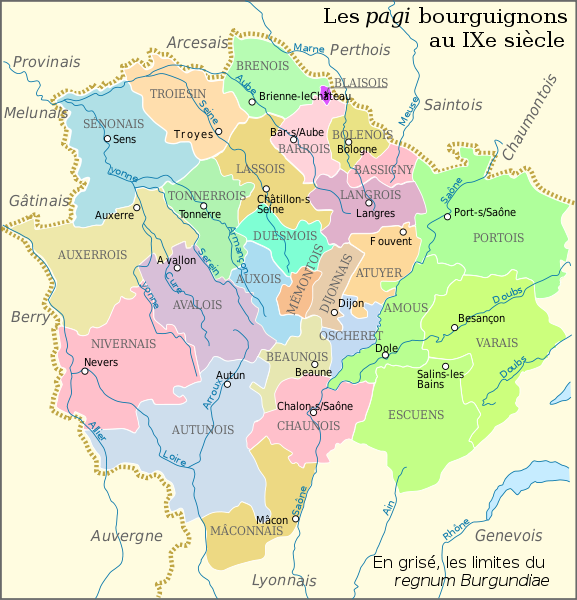The region of Franche-Comté has known a relatively stable territorial identity for a long time. Its formation was dictated partly by geographical features surrounding it, and at the discretion of the peoples who took control over the centuries.
Land of Celtic tribes
Long before the region was called Franche-Comté, the territory was occupied by a Celtic tribe during the 4th century, the Sequani, giving the locality the name of Sequania. The Celtic peoples were perpetually in conflict with their neighbours, according to interests and games of alliance, in particular the Aedui and the Sequani who disputed the tolls on the Saône. The Sequani were allied to the Romans, which pushed their opponent to call for the help of the Germans led by Ariovistus in 71 BC. The latter conquered the entire region in 68 BC, turning on his old allies.[1]

Integration to Rome
In 58 BC. AD, the Helvetii, led by King Orgetorix, began a migration to Saintonge. They crossed the Jura passes and invaded the territory of the Sequani. They asked Julius Caesar for help. The latter, having ambitions in Gaul, came to their aid. He pushed back the Helvetii on the other Jura flank and the Germans of Ariovistus beyond the Rhine, but forced the Sequani to return the territories previously taken from the Aedui. This event marked the beginning of the Gallic war during which the Sequani took part in the Gallic revolt alongside Vercingetorix. The surrender of Vercingetorix on September 27, 52 BC. J.-C. put an end to Gallic independence, and it was from Bibracte, where he spent his winter quarters, that Caesar wrote his of Bello Gallico. The imperator also granted clemency to the vanquished: he gave the Aedui the status of civitas foederata (“federated city”). Sequania became part of the provinces of the Roman Empire until its conquest by the Burgundians in 485[2], then by the Frank in 534 AD.
- [1] NISARD, M. (1865). Salluste, Jules César, C. Velléius Paterculus et A. Florus : Oeuvres complètes avec la traduction en français / publiées sous la direction de M. Nisard / saisi optiquement et revu par Jean Schumacher. (Paris).
- [2]PEYRE, M. J.-F.-A. (1855). Lois des Bourguignons, vulgairement nommée Loi Gombette / traduites pour la première fois par M. J.-F.-A. Peyré.
Merovingians rule

After the death of Louis the Pious in 840, its descendants would wage war over what was left of the Empire of Charlemagnes. Lothaire was beaten by his brothers Charles the Bald and Louis II and forced in the treaty of Verdun in 843, creating the territory of Imperial Burgundy and Frank Burgundy. Those territories would reunite in the Kingdom of Two Burgundy around 933. This kingdom was later overtaken by Otte-Guillaume of Burgundy, who managed to gain a large independance from the King of High Burgundy and created the county of Burgundy around 982, with its territory corresponding approximatively to the current region of Franche-Comté for the centuries to come.